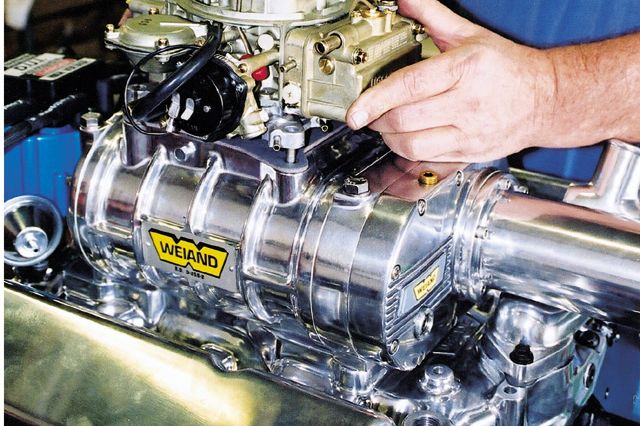(image © superchevy.com)
Q: I am getting ready to pull the trigger on a supercharger for my 1966 Chevelle. What should I do about my carburetor? Do I need to go larger to accommodate the increased airflow requirements of the supercharger? What else can you tell me about achieving the right carb setup for my application?
A: To make maximum power and boost you’ll usually need a larger carburetor(s). That’s because a blown engine can require 50 percent more air than a naturally aspirated engine when operating at full throttle. However, if your supercharged engine is primarily driven on the street at moderate engine speeds (under 4,000 rpm), you don’t necessarily need a larger carburetor.
Typically the carburetors(s) will need to be enriched by 5 to 10 percent on the primaries and 10 to 20 percent on the secondaries. The idle mixture screws may need to be enriched by one or two turns. In either case, the carburetors need to be jetted properly to prevent a lean condition, which can lead to detonation. If you notice glowing red headers, an audible popping, or engine surging, your carburetor is too lean.
For initial start-up, it is actually better to have a slightly rich condition to help prevent the engine from overheating. After initial start-up, check the spark plugs for proper reading and adjust the carburetor(s) accordingly. You want to see a medium to dark tan color.
If you run one or more Holley carburetors, also be aware they contain power valves. Power valves provide additional fuel when there is no vacuum at the base of the carburetor. However, in a blower application, there will always be some vacuum, so the power valves will not function properly. You will need carburetors that have a “boost referenced” power valve circuit.
…
You can read more Mailbag features by clicking here.


Why buy anything for a blown engine? Just sweep up the broken pieces and toss the whole thing in the dumpster! 🙂
Formula shown in article is incorrect. The formula below will help you determine the correct size carbs for any blown application.
[(DxR)/3456] x [(B/14.7)+1]=C
D = Cubic inch displacement of the motor
R = Maximum engine RPM
B = Maximum blower boost
C = Maximum CFM required
Hello I got a 468 bbc full roller blower boat motor running a single 1050 dominator carburetor 720 HP do i need too go 2 750 or 850 carburetor.
I run two 600 cfm on mine, it’s a street engine, 671 blower 1.1, 468ci, rev limiter set to 6000rpm, 1200 cfm is max for for rpm but runs great for street, if your going higher on rpm need bigger carbs or cfm
I got a 468 bbc with a 6/71 an single 1050 dominator or do I need 2 750
I have a BBC 454 871 blower. Put 2 800 cfm Edelbrock AVS carbs. Increased needle and seats and jets. Dont have to worry at all about boost reference or power valves. Runs awesome no issues.
You should probably change the floats in the carb so they won’t collapse because of the blower.
well first of all the carb should be blower carb not go the cheap way like alot of guys do!! next you need a good msd ignition that much air going into the cylinders puts the fire out thats just some of the things to do !!!!!!!
“Carby”. Just bite the bullet and go for a Holley afternarket injection system. Even looks like a carby at first glance, and runs MUCH better.
I was curious if it’s okay to run a 650 Dominator carburetor on a 177 Wheeling blower on a 350 with a mild Cam and MSD ignition. Do I have to get a special carburetor that goes on blowers or we just Dominator do the job that I’m looking for.